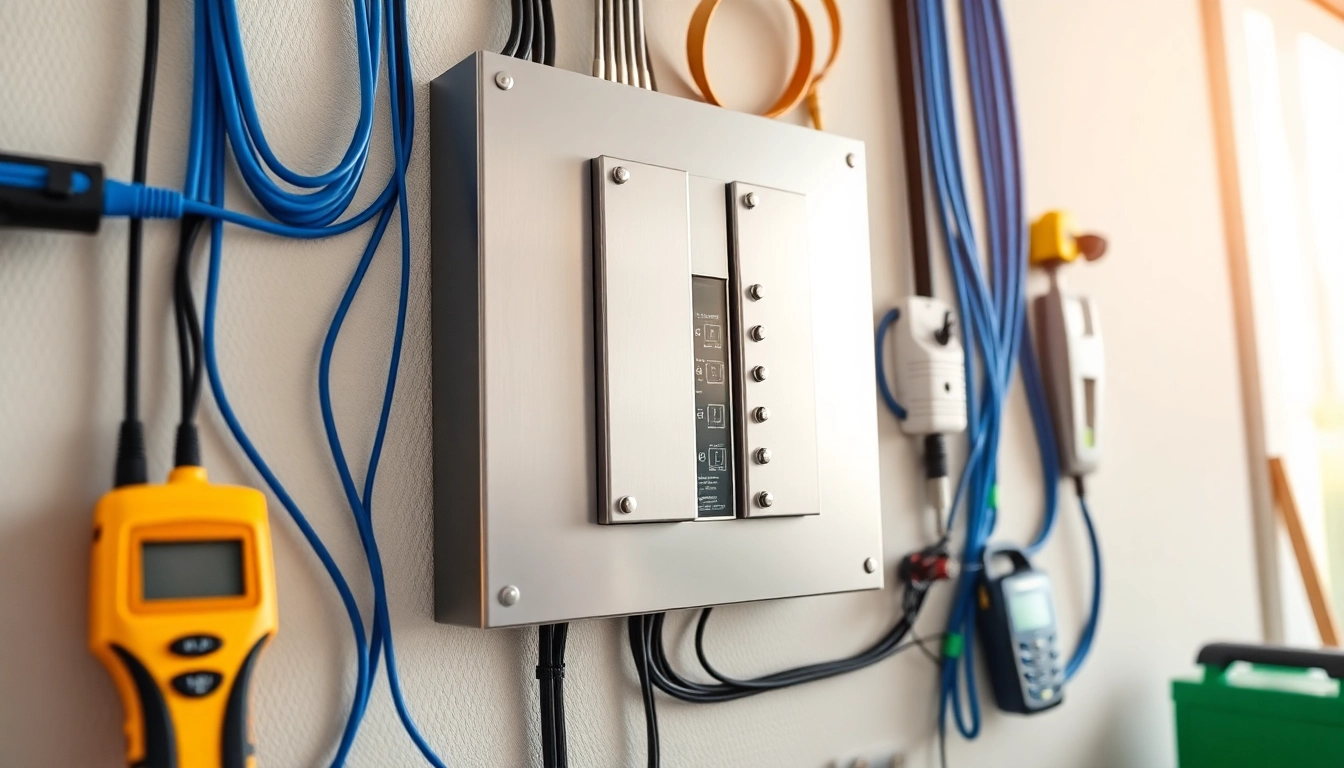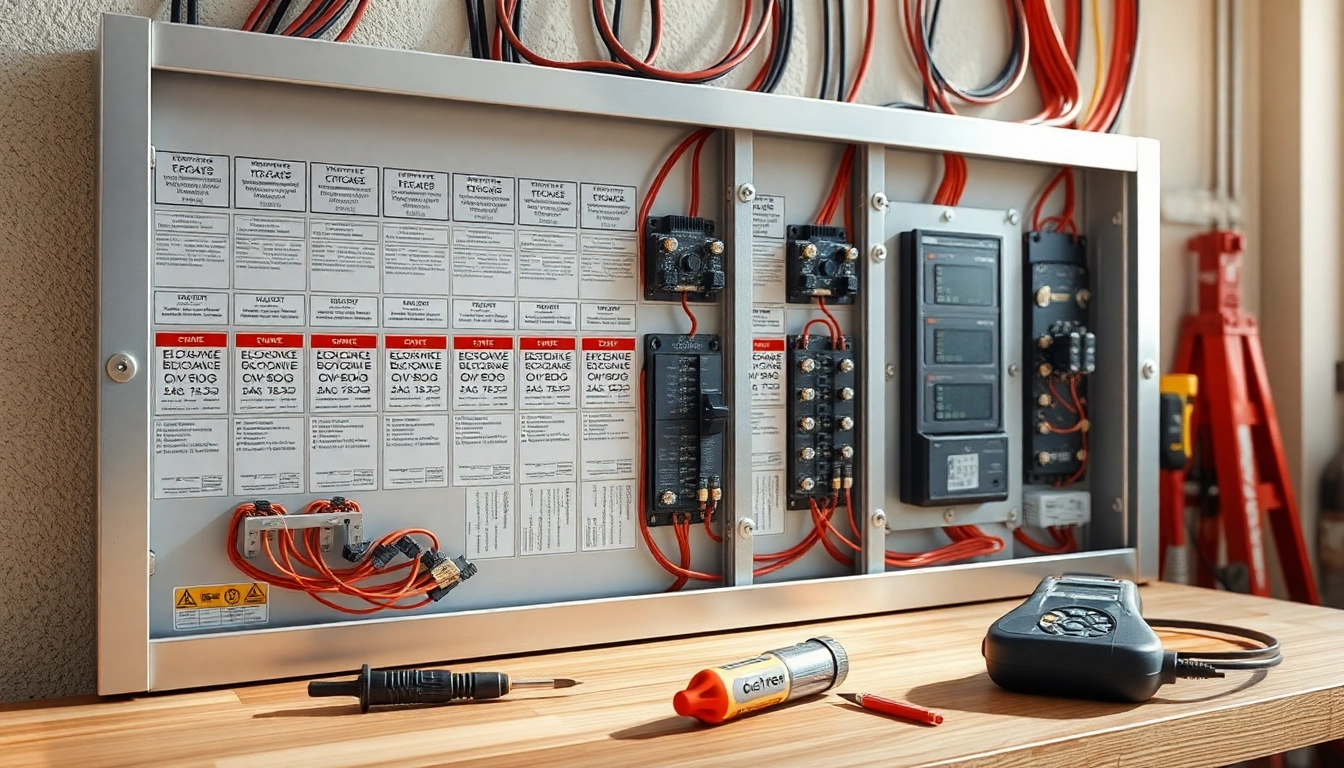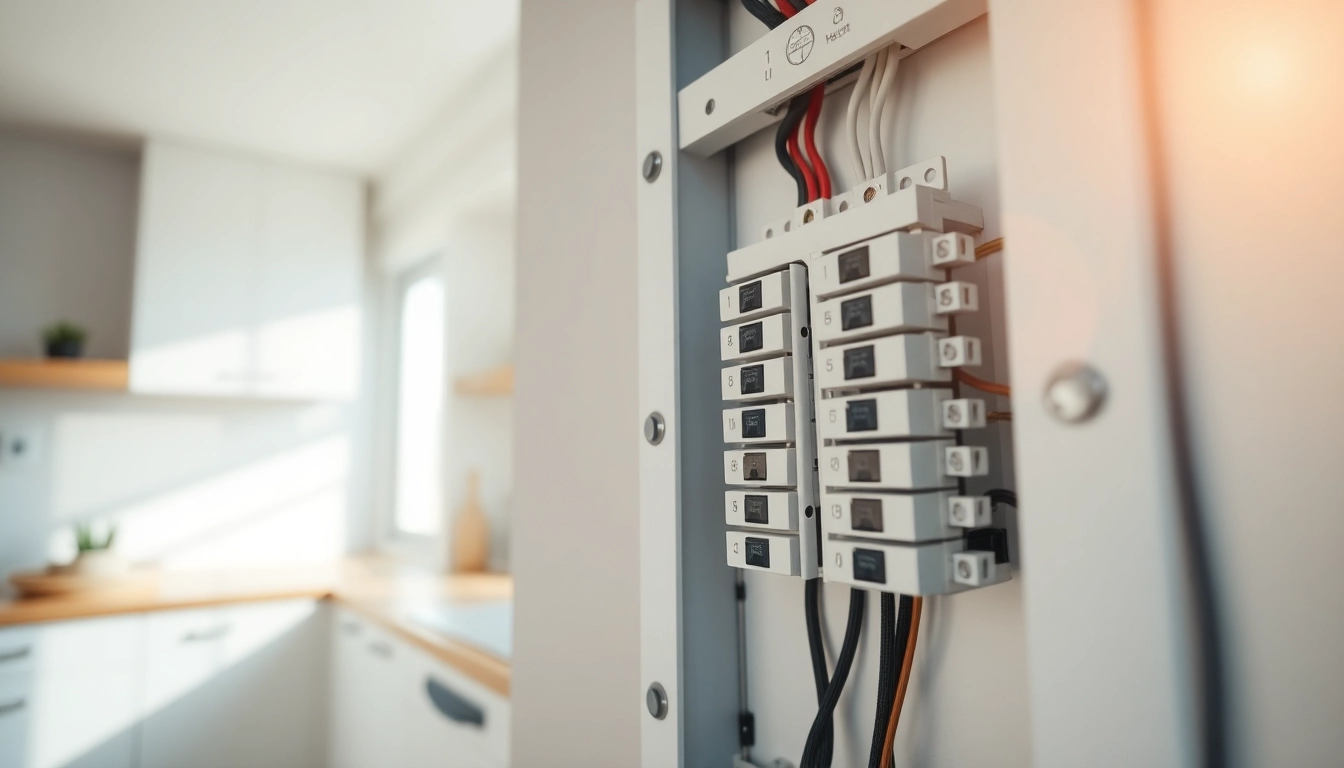
Understanding the Basics of Electrical Panels
What Is an Electrical Panel?
An electrical panel, often referred to as a breaker box, is a critical component in any residential or commercial electrical system. It acts as the central hub for electrical distribution, managing the flow of electricity throughout a building. The panel is responsible for receiving electricity from the utility company and distributing it to various circuits, ensuring that power is effectively and safely delivered where it is needed. Understanding its function is key to maintaining a safe and efficient electrical system.
Key Functions of Electrical Panels
Electrical panels serve several essential functions that are vital for your home’s power system:
- Distribution of Power: The primary role of an electrical panel is to distribute electrical power to various circuits throughout the home. The panel connects to the main power supply and directs electricity to designated circuits based on their requirements.
- Overload Protection: By using circuit breakers, an electrical panel protects your home from overloads or potential electrical fires. Circuit breakers automatically cut off power to a circuit when the current exceeds its designated level.
- System Monitoring: Modern electrical panels can also offer monitoring capabilities, allowing homeowners to track electricity usage. This can aid in identifying high consumption areas, leading to better energy management.
- Convenience for Repairs: When issues arise in your electrical system, the panel makes it easier for electricians to troubleshoot problems by providing a central location to isolate circuits.
Types of Electrical Panels Explained
There are several types of electrical panels, each designed for specific uses and applications:
- Breaker Panels: The most common type, used in residential settings. These panels contain circuit breakers that trip in case of overloads.
- Subpanels: These panels are used to distribute power to specific areas of a home, often located away from the main panel.
- Transfer Switches: Used for backup generators, these switches allow the safe transition of power from the utility to a generator.
- Smart Panels: Equipped with technology for enhanced monitoring and control, smart panels can provide real-time data on electricity consumption.
Signs That Your Electrical Panel Needs an Upgrade
Common Indicators of Electrical Panel Issues
Recognizing when your electrical panel may need an upgrade is critical for maintaining safety and efficiency in your home. Here are several common indicators:
- Frequent Trips: If your circuit breakers are tripping regularly, it may indicate that your panel cannot handle the electrical load.
- Old Age: Electrical panels have a lifespan, typically around 20-30 years. If your panel is approaching or exceeding this age, a replacement should be considered.
- Burning Smell: Any indication of a burnt smell from your electrical panel is a serious sign of malfunction and requires immediate attention.
- Older Fuse Systems: Homes with fuse boxes rather than modern breaker panels are advised to upgrade due to the inability of fuses to provide adequate overload protection.
Safety Risks Associated with Outdated Electrical Panels
Updating your electrical panel is not merely a matter of convenience; it has significant safety implications. Older panels may not meet current electrical codes and could pose risks such as:
- Fire Hazards: Faulty wiring and outdated technologies can lead to overheating and fire.
- Electrocution Risks: Insufficient protection can expose users to potentially lethal shocks.
- System Failures: An overloaded panel may cause systems to shut down unexpectedly, leading to additional issues.
Assessing Your Home’s Electrical Needs
Before concluding on an upgrade, homeowners should assess their electrical requirements:
- Appliance Usage: Evaluate the total power consumption of all appliances and devices.
- Potential Additions: Consider future needs, such as home expansions or added electrical devices, when assessing capacity requirements.
- Consulting Professionals: Enlisting an electrician to conduct a load analysis can provide valuable insights tailored to your specific situation.
Choosing the Right Electrical Panel for Your Home
Factors to Consider When Selecting an Electrical Panel
Choosing the right electrical panel is crucial for safety and efficiency. Here are key factors to consider:
- Amperage: The amperage rating (commonly 100, 150, or 200 amps for residential settings) should be sufficient to handle existing and anticipated electrical loads.
- Number of Circuits: Ensure the panel has enough circuits to accommodate your home’s needs without overcrowding.
- Type of Breakers: Look for panels that use high-quality circuit breakers, as this will impact the overall safety and longevity of the system.
- Regulatory Compliance: Verify that the panel meets local building and safety codes, ensuring compliance and safety for your specific region.
How to Compare Electrical Panel Brands
When exploring various brands and types of electrical panels, consider the following:
- Warranty and Customer Support: A strong warranty and responsive customer service are key factors in long-term satisfaction.
- Reputation and Reviews: Gauge experiences from other homeowners and professionals to assess the reliability and performance of different brands.
- Energy Efficiency Ratings: Panels that help monitor energy consumption can lead to cost savings over time through better efficiency management.
Experts’ Recommendations on Electrical Panels
Industry experts often recommend specific brands based on performance and reliability. Some reliable brands include:
- Square D: Known for its reliability and range of products suited for residential use.
- Siemens: Offers innovative solutions and a variety of options tailored to different requirements.
- Eaton: This brand provides a strong selection of circuit breakers and panels with a focus on safety and efficiency.
- Genova: Noteworthy for its cost-effective solutions that provide solid performance.
Installation and Maintenance of Electrical Panels
Step-by-Step Guide to Electrical Panel Installation
Installing an electrical panel is a complex process best performed by a qualified electrician. However, understanding the basic steps can help homeowners grasp what the installation entails:
- Turning Off Power: Before installation, ensure all power is turned off to avoid electrical hazards.
- Removing the Old Panel: Carefully detach the existing panel, taking note of all wiring configurations.
- Mounting the New Panel: Securely install the new panel at an appropriate height, ensuring easy access while complying with building codes.
- Wiring Connections: Connect all circuits to the new panel, ensuring proper handling of the wires to avoid shorts.
- Final Checks: Verify all connections for safety, then reset the system to check if everything functions correctly.
Routine Maintenance Tips for Electrical Panels
Proper maintenance is essential for the longevity and performance of your electrical panel:
- Regular Inspections: Conduct annual inspections to check for signs of wear, frayed wiring, or rust.
- Keep the Area Clean: Maintain a clutter-free space around the electrical panel for safety and accessibility.
- Check Breaker Functionality: Ensure circuit breakers trip appropriately by periodically testing them to prevent malfunctions.
- Documentation: Maintain detailed records of maintenance performed, upgrades, and any repairs needed.
When to Hire a Professional Electrician
While some electrical tasks may seem manageable for homeowners, certain situations warrant hiring a professional:
- Complex Installations: Larger homes may require multiple panels or intricate wiring configurations best handled by professionals.
- Uncertainty About Safety Standards: If unsure about local code compliance or safety regulations, consulting a licensed electrician is prudent.
- Persisting Electrical Issues: Recurring electrical problems should never be ignored and should be assessed by a qualified expert to avoid hazards.
Cost Considerations for Upgrading an Electrical Panel
Average Costs Associated with Electrical Panel Replacement
The cost of upgrading or replacing an electrical panel can vary based on several factors:
- Panel Size: Larger and higher-amp panels typically cost more, with prices for materials alone ranging from $500 to over $1,500.
- Labor Costs: Professional installation can add anywhere from $300 to $1,000 depending on job complexity.
- Permits and Inspections: Local regulations may require permits that can add up to $200 to $500 in costs.
Cost-Benefit Analysis of Upgrading Your Electrical Panel
While the upfront cost of upgrading your electrical panel may seem high, consider these long-term benefits:
- Improved Safety: Higher safety standards reduce the risk of electrical fires and hazards, providing peace of mind.
- Increased Property Value: Upgrading enhances your home’s market appeal, particularly for future buyers concerned about electrical safety.
- Energy Efficiency: Modern panels often handle electrical needs better, potentially decreasing energy costs over time.
Financing Options for Electrical Panel Upgrades
If cost is a concern, there are various financing options available for homeowners:
- Home Equity Loans: Utilizing equity in your home can provide lower-interest loans tailored for home improvements.
- Credit Cards and Personal Loans: For smaller upgrades, credit cards or personal loans can offer quick access to funds.
- Government Grants and Programs: Depending on your location, there may be financial aid available for energy efficiency upgrades, including electrical panels.







